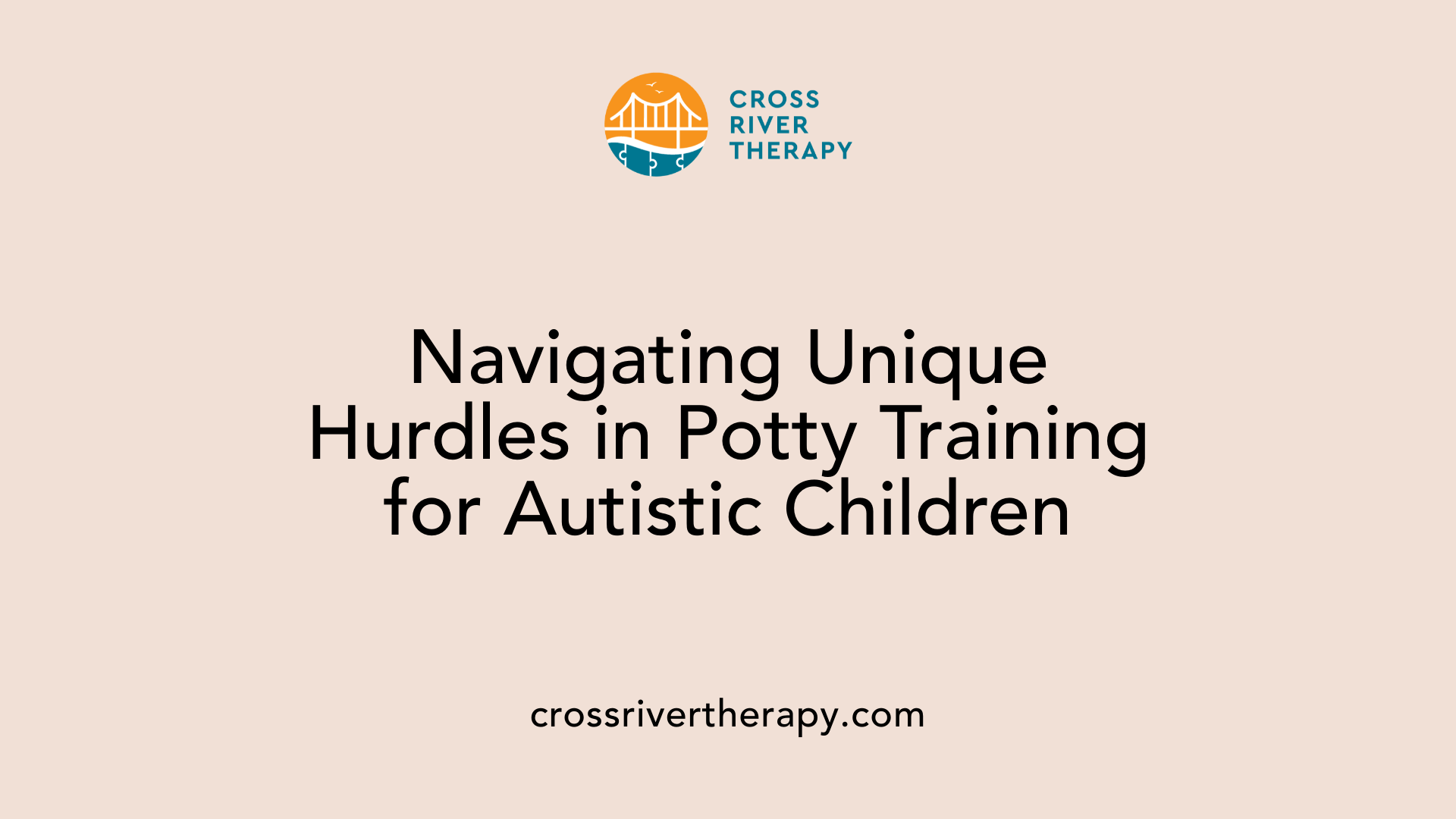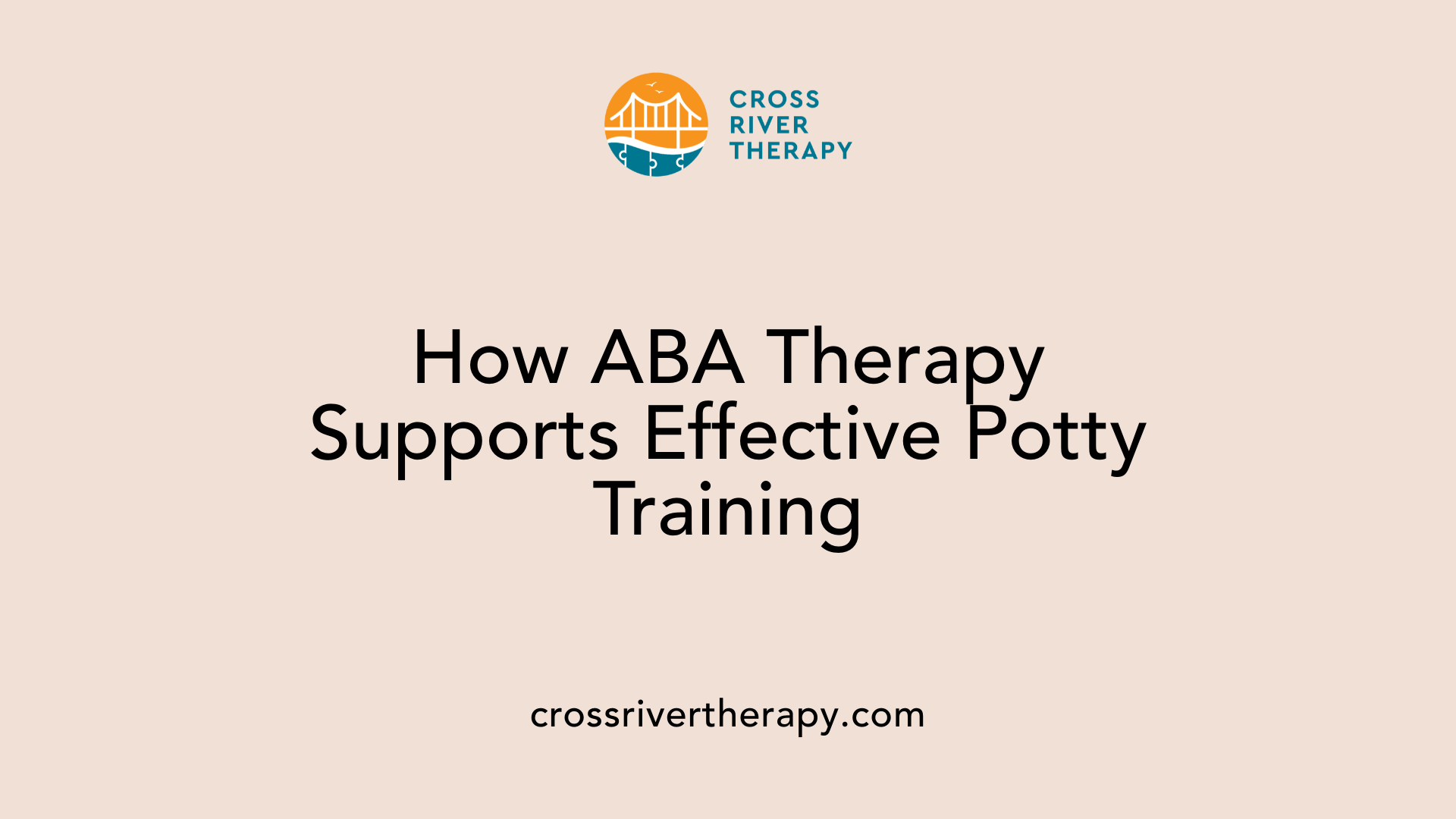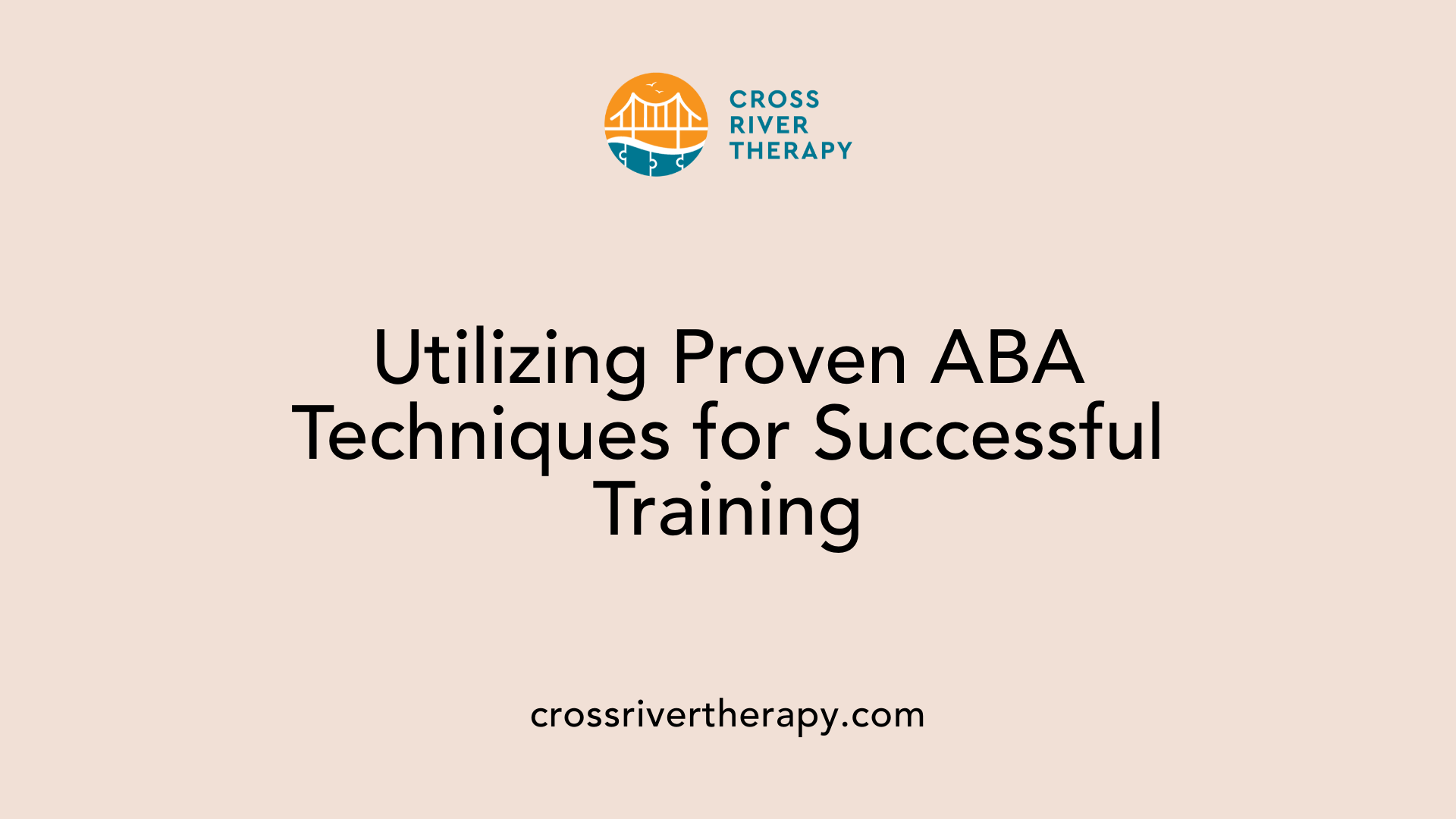How Cross River Therapy Helps with Toilet Training Through ABA
Unlocking Potty Training Success for Autistic Children with Cross River Therapy
Introduction to Cross River Therapy in ABA Potty Training
Navigating the journey of toilet training can be challenging for any parent, but it can be particularly daunting for those with autistic children. These children often face unique hurdles due to sensory sensitivities and communication barriers. Cross River Therapy utilizes applied behavior analysis (ABA) to support families in overcoming these difficulties and fostering successful toilet training. This article will explore how Cross River Therapy employs evidence-based ABA techniques to tailor potty training strategies that meet the individual needs of autistic children.
Understanding Autism and Potty Training Challenges

Unique challenges faced by autistic children during potty training
Potty training for autistic children often presents unique hurdles. Many kids with autism experience sensory sensitivities that can make the bathroom environment overwhelming. The sounds, smells, and textures involved in using the toilet may provoke anxiety or discomfort, creating resistance to the training process. Communication issues further complicate matters, as these children might struggle to express their needs or understand instructions.
Additionally, changes in routine can cause distress. Autistic children may be accustomed to specific patterns in their daily lives, and any deviation can lead to anxiety or setbacks in learning. Therefore, fostering a routine that incorporates potty training within their established framework can be beneficial.
What challenges do children with autism face with toilet training, and how can they be addressed?
Children with autism face several challenges during toilet training, including sensory sensitivities, communication difficulties, and resistance to changes in routine. These factors can lead to anxiety or discomfort around the bathroom environment, making the process more complicated. To address these challenges, it's essential to create a comfortable bathroom setting, utilize visual supports and schedules, and implement gradual steps through techniques like shaping.
Consistent communication, monitoring readiness signs, and consulting with professionals can provide tailored strategies to support the child's needs. Positive reinforcement—such as offering rewards for every success—can motivate and empower children, encouraging more frequent use of the toilet.
Together, these strategies not only support the child through the potty training process but also help build a solid foundation for future developmental milestones.
Role of ABA in Potty Training for Autistic Children

How can ABA therapy help with potty training?
ABA (Applied Behavior Analysis) therapy can significantly support potty training for children with autism by providing structured, evidence-based approaches tailored to individual needs. It addresses unique challenges specific to autistic children—such as communication difficulties, sensory sensitivities, and rigid routines—that might complicate the potty training process.
The use of positive reinforcement is central to all ABA techniques. Praising or rewarding a child immediately after a successful toileting task strengthens the connection between the behavior and the reward, encouraging them to repeat it. Visual aids, such as picture schedules or social stories, also play a crucial role. They assist children in understanding routines and expectations without relying solely on verbal communication.
Benefits of ABA therapy for potty training
- Tailored Strategies: ABA therapy employs individualized plans that cater to developmental levels and unique behaviors of each child.
- Structured Learning: Through structured teaching methods, children learn toilet training and related life skills in a systematic manner.
- Communication Aids: Using visual prompts can help nonverbal children express their needs and understand when to use the toilet.
- Routine Establishment: Established routines reduce anxiety and help children adapt more smoothly to toileting tasks.
- Error Correction: ABA therapists teach parents to minimize fuss about accidents, which alleviates pressure and helps kids focus on successes instead.
Incorporating these strategies can build a supportive environment that makes potty training manageable. Research shows that with a consistent ABA-based approach, many children can achieve significant progress in as little as a few days, emphasizing the power of repeated practice and positive reinforcement.
Evidence-Based Techniques in ABA for Toilet Training

Effective ABA techniques used in toilet training
Applied Behavior Analysis (ABA) has proven to be effective in teaching toilet training skills to children with autism. Techniques such as shaping, graduated guidance, and scheduled toileting are often utilized. These methods involve gradually reinforcing desired behaviors, helping children learn through structured instructions.
Some specific ABA strategies include:
- Positive Reinforcement: Immediate rewards after successful toilet use can strengthen the connection between the action and the reward.
- Visual Prompts: For nonverbal children, using pictures or visual schedules can communicate the steps of toilet training effectively.
- Graduated Guidance: This involves providing minimal assistance initially, then increasing it if needed, until the child can toilet independently.
Importance of tailored strategies
Tailoring strategies to fit the individual child's age and cognitive abilities is essential for success. A review of various intervention studies reveals that personalized approaches yield better outcomes. For instance, a modified rapid toilet training method is often recommended, which encompasses intense training sessions lasting 1-2 weeks.
By aligning the training process with the child’s specific needs, therapists can maximize developmental outcomes. Early intervention is crucial. The sooner strategies are implemented, the higher the chances of achieving independence in toileting skills.
In summary, employing evidence-based ABA techniques, such as tailored schedules and effective communication methods, is vital for successful potty training. Addressing both sensory and behavioral challenges helps pave the way for children to master this essential life skill, ensuring they can transition smoothly from diapers to underwear.
| Approach | Description | Benefit |
|---|---|---|
| Positive Reinforcement | Rewarding successful attempts at using the toilet | Increases motivation and encourages repetition |
| Visual Prompts | Using images to outline the toilet training process | Helps nonverbal children understand routines |
| Graduated Guidance | Providing varying levels of assistance to encourage independence | Builds confidence and self-sufficiency over time |
Positive Reinforcement in Toilet Training

Role of Positive Reinforcement in Facilitating Toilet Training
Positive reinforcement plays a vital role in potty training for autistic children. It encourages them by acknowledging their successes, which is essential given the unique challenges they face, including sensory sensitivities and communication barriers. When a child successfully uses the toilet, immediate praise or tangible rewards can create positive associations with the behavior. This encourages repeat behavior and helps children feel accomplished.
Developing a routine that includes regular potty breaks and celebrating milestones can significantly bolster a child's motivation. Since many autistic children thrive on patterns, incorporating predictable reinforcement strategies fosters a sense of security.
Techniques for Rewarding Successes
Effective techniques for rewarding successes during potty training include:
- Visual Rewards: Stickers or chart systems where children can add a sticker every time they successfully use the toilet.
- Tangible Rewards: Small toys, treats, or privileges that can be earned after a certain number of successful toilet uses.
- Verbal Praise: Specific and enthusiastic praise fosters positive feelings. For instance, saying, "Great job using the toilet!" reinforces behavior.
- Immediate Feedback: Recognizing achievements right after they happen strengthens their understanding that good outcomes follow appropriate bathroom behavior.
What is the Most Successful Potty Training Method?
The most successful potty training method involves a combination of consistency, patience, and positive reinforcement. Start by ensuring that your child is physically and emotionally ready for potty training, typically between 2 to 3 years old. Introduce a routine, encouraging regular bathroom visits and celebrating successes to boost their confidence. Use incentives such as stickers or praise to motivate your child and maintain a relaxed atmosphere to reduce stress. Expect accidents along the way, and approach them with understanding rather than punishment, as this will help your child feel secure and willing to learn.
Creating a Conducive Environment for Training
Adapting Amenities for Sensory Sensitivities
When potty training autistic children, it's crucial to adapt amenities that cater to their sensory needs. This might include soft lighting in the bathroom to avoid overwhelming bright lights, as well as textured materials for the potty seat that are comfortable for the child. Consider using a training toilet that is appropriately sized, ensuring it doesn’t make the child feel unsafe or uncomfortable. Soundproofing elements, like soft rugs or curtains, can also help diminish distracting noises, thus creating a calming environment.
Ensuring Comfort in the Training Setup
Comfort is paramount during the potty training process. Choose a potty that feels stable and secure for the child, preventing any anxiety associated with wobbliness. Also, consider the temperature of the bathroom—cold surfaces might deter usage, so maintaining a warm atmosphere can enhance comfort.
Integrating a familiar item, like a favorite toy or book in the bathroom, could also foster a sense of security. Consistency in the training setup—always having the potty in the same place—can help establish a routine, making it easier for the child to understand when and where they are expected to go.
How to help an autistic child with toilet training?
To aid an autistic child with toilet training, utilize visual supports and establish clear routines to promote understanding and reduce anxiety around the process. Start with incorporating regular bathroom breaks into the daily schedule and use a timer or visual reminders to encourage consistent use. Transitioning quickly to underwear helps the child connect wetness with the need to go to the toilet. Reward systems, particularly immediate rewards for successful attempts, along with gentle encouragement during accidents, can help motivate the child. If difficulties persist, consulting a behavioral therapist or clinician specializing in autism for tailored support can be extremely beneficial.
Significance of Structured Teaching Methods in ABA
Structured methods like shaping and graduated guidance
Structured teaching methods play a pivotal role in toilet training for children with autism. Techniques such as shaping and graduated guidance systematically help children learn essential skills while accommodating their individual learning styles.
- Shaping involves gradually reinforcing closer approximations to the desired behavior, which in this case is using the toilet. Children are rewarded as they make progress, motivating them to continue improving.
- Graduated guidance provides support while encouraging independence, using prompts that decrease over time as the child becomes more proficient in the task.
Tailoring methods to individual needs
Each child with autism has unique needs, so it's crucial to tailor these ABA methods accordingly.
- Age and cognitive ability: The strategies must correspond to the child's developmental level to ensure effective learning.
- Communication skills: For nonverbal children, visual aids or picture schedules can be integrated into the teaching process, allowing them to understand expectations better.
By utilizing these structured approaches, parents and therapists can create customized potty training plans that not only address individual challenges but also enhance the likelihood of success. The goal is to promote independence and help children develop lifelong skills.
Addressing Communication Barriers Through ABA
Communication Strategies in ABA
Communication challenges can pose significant hurdles in potty training for children with autism. ABA (Applied Behavior Analysis) therapy offers targeted strategies to address these barriers. Therapists focus on enhancing communication skills, which are crucial for expressing needs related to using the toilet. This can involve teaching children to use simple phrases or symbols to signal when they need to go.
Using Visual Aids and Schedules
Visual supports play a vital role in the potty training process. Employing visual aids such as picture schedules helps clarify expectations and routines for children, especially those who are nonverbal. For instance, using images to depict the steps of toileting—from recognizing the urge to wash hands afterward—can reinforce learning. This structured method not only aids comprehension but also creates a predictable environment, making the transition smoother for children with autism.
Moreover, offering a visual toilet chart can encourage consistency by allowing children to track their successes. When successes are recognized and rewarded promptly, it fosters a positive connection to using the toilet and enhances motivation, making potty training an engaging learning experience.
Understanding Readiness and Routine Development
Identifying Readiness Signs
Potty training for autistic children often differs from typical approaches due to unique developmental challenges. To identify when a child may be ready for potty training, parents and caregivers can look for specific behaviors. Common readiness signs include seeking privacy before soiling their diaper and showing an ability to follow basic instructions.
It's vital to recognize that each child is unique, and readiness may manifest in different ways. Early attention to these signs can lead to successful potty training experiences.
Establishing Routines and Schedules
Establishing a structured routine is crucial during the potty training process. Children with autism benefit from consistent schedules that help them understand what is expected. This can include scheduled toileting times throughout the day to create predictability.
Adjustments to the environment may also be necessary, particularly regarding sensory sensitivities. Soft lighting and comfort in potty equipment can make the process smoother. Developing a routine ensures children feel secure, making it easier to adapt to the changes involved in learning to use the toilet.
By focusing on these elements—recognizing readiness and creating structured routines—parents can facilitate a more successful potty training experience for their autistic children.
Importance of Fluid Intake and Practice Frequency

Encouraging fluid intake for more practice opportunities
Fluid intake plays a pivotal role in potty training for children with autism. Increasing the amount of fluids consumed can create more opportunities for urination, which in turn leads to more chances for the child to practice using the toilet. This method aligns with the goal of achieving around 20 learning trials each day during the training process.
To encourage higher fluid intake, you can offer preferred beverages, such as fruit juices or even soft drinks, as a way to make drinking more appealing. Incorporating salty snacks can also stimulate thirst, promoting increased fluid consumption. This strategy not only enriches practice opportunities but also fosters a sense of routine around mealtimes, making training feel more integrated into daily life.
Linking increased urination with learning trials
When a child begins to have more frequent urination due to elevated fluid intake, it presents valuable learning opportunities. Each successful visit to the toilet helps solidify positive behaviors through immediate rewards, reinforcing the connection between using the toilet and receiving praise or treats. This immediate feedback loop is vital in encouraging continued engagement with the toilet training process.
By systematically increasing fluid intake, parents and caregivers can enhance the effectiveness of potty training sessions while also promoting overall hydration, which helps reduce the risk of constipation and urinary tract infections (UTIs). Engaging children in a fun and rewarding way can ultimately lead to successful toilet training outcomes in a shorter timeframe.
Visual Supports and the Transition to Independence
Using visual aids in guiding potty training
Visual aids play a crucial role in potty training for children with autism, especially for those who are nonverbal. Simple pictures or visual prompts can effectively communicate routines and expectations. For instance, creating a sequence of images that illustrate the steps of using the toilet helps children understand what is expected of them.
Additionally, using color-coded charts or stickers can reinforce positive behaviors. Following each successful toilet use with a visual reward connected to their achievements creates a consistent and recognizable system of communication.
Empowering children for independent toileting
Empowering children to express their toileting needs is essential for fostering independence. Visual aids or assistive communication devices can facilitate understanding and compliance. A picture that represents the toilet can serve as a prompt, enabling children to indicate when they need to go.
Moreover, training sessions should aim for about 20 learning trials each day, increasing the chances for children to practice using the toilet successfully while reinforcing their understanding. Through these strategies, children can develop the skills necessary for independent toileting, thus easing the transition from diaper use to using underwear.
Long-term Benefits of ABA-Structured Training
Impact on daily living skills beyond toilet training
Toilet training is a vital part of life skills for children with autism, and ABA therapy plays a significant role in this process. The systematic approach often used in ABA, such as teaching through positive reinforcement and structured methods, helps children develop not just potty skills but also broader self-care routines. This conceptual learning extends beyond the bathroom. Children become adept at following instructions and managing personal hygiene, paving the way for independence in other areas of daily living.
Enhancing adaptation to social and school environments
Successfully mastering toilet training can dramatically influence a child’s adaptation to social and educational settings. As children learn to manage their toileting needs, they experience increased confidence and diminished anxiety in situations where bathrooms are available, such as during playdates or in school. With effective potty training, children are more likely to engage with peers and participate actively in group activities, which can enhance their overall social development.
Overall, the skills acquired through ABA-structured toilet training contribute to better personal autonomy and social integration, which serve as crucial milestones in the growth of children with autism.
Embracing a Tailored Approach for Success
Cross River Therapy's approach to potty training through ABA offers a beacon of hope for parents grappling with the unique challenges presented by autism. By employing structured methods, positive reinforcement, and tailored strategies that respect individual needs, families can look forward to achieving success. The combined efforts of ABA professionals and caregivers ensure that autistic children are not only equipped with the necessary toileting skills but are also prepared to thrive in broader social and educational environments. As more parents embrace these methodologies, the path to confident and independent potty training becomes ever more accessible.
References
- How to Potty Train an Autistic Child: Therapist's Top Tips - Blue ABA
- How ABA Therapy for Toddlers Actually Works
- Behavioral Interventions for Autism Spectrum Disorder
- Seven toilet training tips that help nonverbal kids with autism
- Toilet Training a Child with Autism - Achievements ABA Therapy
- Occupational therapy and potty training - Ability Innovations
- Toilet Training Tips for Children with ASD, ADHD, and ...
- Seven toilet training tips that help nonverbal kids with autism
- Autism toilet training dilemma
- Toilet (Potty) Training - Autism Speaks



